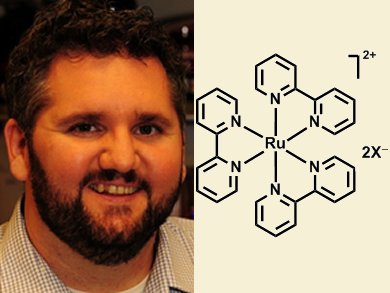Professor Corey R. J. Stephenson, University of Michigan, Ann Arbor, USA, has received the EROS Best Reagent Award 2014 for his research into ruthenium(II) tris(2,2′-bipyridine-κN1, κN1′)-, (OC-6-11)-.
The award is sponsored by Aldrich® Chemistry and John Wiley & Sons and was established to recognize the work of the authors of the online edition of Encyclopedia of Reagents for Organic Synthesis (e-EROS). Every year, 200–300 synthetic chemists contribute articles to e-EROS and the Editorial Board makes a shortlist of their favorite reagents from among these articles. The Award Committee then select the winner from this shortlist. Stephenson receives $10,000 for winning and will be awarded at the 247th ACS National Meeting & Exposition, Dallas, TX, USA, on March 16.
The Reagent: Ruthenium(II), Tris(2,2′-bipyridine-κN1,κN1′)-, (OC-6-11)-
This complex was introduced long ago but it has enjoyed a renaissance in the past five years as a photoredox catalyst. By harnessing the energy of visible light, it allows a variety of organic transformations including cycloadditions, alkylations, halogenations, reductions, cyclizations, and ring-openings to occur under mild conditions. The article on the award-winning reagent by Laura Furst and Corey Stephenson was published in EROS in September 2012.
Corey R. J. Stephenson studied chemistry at the University of Waterloo, Canada. In 2004, he obtained his Ph.D. for research on new C–C bond-forming reactions of alkenylzirconocenes and their cascade reaction sequences under the guidance of Professor Peter Wipf at the University of Pittsburgh, USA. After working as a postdoctoral fellow in the group of Professor Erick M. Carreira at ETH Zürich, Switzerland, he began his independent career at Boston University, USA, as an Assistant Professor in 2007. Since July 2013, he has been an Associate Professor in the Department of Chemistry at the University of Michigan.
His research group focuses on catalysis, natural product synthesis, and continuous flow chemistry where visible light-mediated photoredox catalysis is the major theme interconnecting these areas of research.
- Ruthenium(II), Tris(2,2′-bipyridine-κN1,κN1′)-, (OC-6-11)-,
Laura Furst, Corey R. J. Stephenson,
In Encyclopedia of Reagents for Organic Synthesis, John Wiley & Sons, New York, USA, 2012.
DOI: 10.1002/047084289X.rn01445




